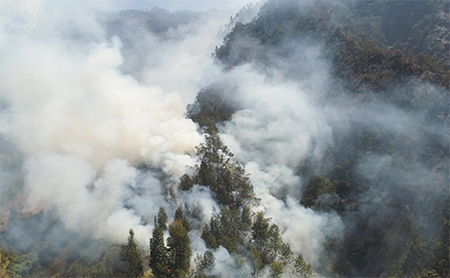Where There’s Fire, There’s Smoke—States Prepare for Health Impacts of Wildfire Smoke
July 11, 2023 | Emma Talkington
 With wildfire season kicking off this summer with fires in Canada causing air quality issues in many parts of the United States, state health agencies are preparing for and responding to the impact of wildfire smoke on community health. According to CDC, wildfire smoke inhalation can cause any number of symptoms, including coughing, chest pain, shortness of breath, and asthma attacks. As the United States begins to see more wildfires during increasingly dry and hot summers and falls, it is important for health agencies to be ready to address concerns from the public and collaborate with other state agencies, like environmental or natural resource agencies, to mitigate the health risks of wildfire smoke.
With wildfire season kicking off this summer with fires in Canada causing air quality issues in many parts of the United States, state health agencies are preparing for and responding to the impact of wildfire smoke on community health. According to CDC, wildfire smoke inhalation can cause any number of symptoms, including coughing, chest pain, shortness of breath, and asthma attacks. As the United States begins to see more wildfires during increasingly dry and hot summers and falls, it is important for health agencies to be ready to address concerns from the public and collaborate with other state agencies, like environmental or natural resource agencies, to mitigate the health risks of wildfire smoke.
West Coast States Prepare Messaging
Communicating appropriate and timely messages to the public about the health risks of wildfires and their smoke is an important step in mitigating health impacts, especially for sensitive groups like children with asthma, people with lung disease, and older adults.
The Washington State Department of Health (WA DOH) has shared Frequently Asked Questions on its website that explain who might be most at risk, how to reduce smoke exposure in a home without air conditioning, and how to appropriately use respirators. WA DOH also developed useful resources for health and air quality officials available in its Smoke from Fires toolkit, including guidance for school and childcare activities and canceling outdoor events.
Several California state agencies, including the California Department of Public Health (CDPH) and the California Environmental Protection Agency, collaborated on a recent update to CDPH’s Wildfire Smoke Considerations for California’s Public Health Officials document due to the increasing frequency and intensity of wildfires. The document, which is California’s version of U.S. EPA’s Wildfire Smoke: A Guide for Public Health Officials, is a comprehensive guide that includes research on how wildfire smoke impacts different communities and vulnerable populations as well as resources and mitigation tools for public health officials.
California also includes considerations for populations with social vulnerabilities. These recommendations include understanding certain mitigation actions may not be an option for some community members (i.e., evacuating, purchasing equipment to keep indoor air clean, etc.) and adapting accordingly. Agencies should use community vulnerability assessments to inform mitigation and response plans to ensure those most at risk are able to protect themselves from wildfire smoke.
Minnesota Collaborates Across State Agencies
While wildfires are typically thought to primarily affect the southwestern and western regions of the country, states elsewhere also deal with wildfires and the impact of wildfire smoke. It’s critical for health agencies to collaborate with other local and state agencies to respond quickly, address potential health and community concerns, and mitigate the short- and long-term impact on communities.
The Minnesota Department of Health (MDH) works closely with its counterparts at the Minnesota Department of Natural Resources, the department primarily responsible for responding to wildfires, and the Minnesota Pollution Control Agency, an agency that monitors both statewide and local air quality. MDH works with both agencies to better understand who is impacted and develop targeted messaging so communities can take informed action to limit their exposure to harmful wildfire smoke. MDH also works with the Minnesota Department of Transportation to develop air quality alert messages for motorists by using traffic notification systems.
Conclusion
As wildfires continue to become more frequent and a major public health concern for more states, it is imperative that state agencies continue collaborating to develop timely and relevant resources to mitigate public concerns and better protect the health and welfare of their communities.
ASTHO will continue supporting states impacted by poor air quality due to wildfire smoke through targeted technical assistance, connections to other states who have extensive experience responding to wildfire smoke, and advocating for increased funding to important environmental health capacity building programs at the federal level such as CDC’s Climate-Ready States and Cities Initiative and the Environmental Public Health Tracking Program.
Special thanks to the Minnesota Department of Health, the California Department of Public Health, and the Washington State Department of Health for providing input used in this blog post. Additionally, special thanks to Nicholas Porter and Emma Carlson for their support in developing this post.